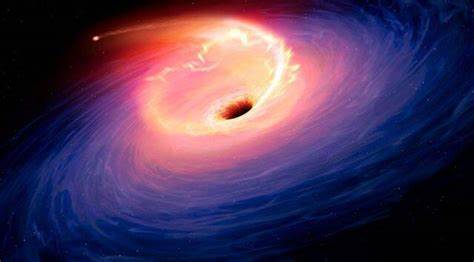The supermassive black hole ripping apart the star is one of the most energetic, luminous and transient celestial events that has been discovered, and yet, it is not exactly blazing bright in the night sky. Instead, astronomers had to unearth evidence of the star’s dying moments from a mass of telescope data where it had been hiding undetected for years.
Scary Barbie” is the affectionate nickname astronomers are calling one of the most energetic and luminous transients ever observed: a supermassive black hole tearing apart a massive star, as in this illustration.

A supermassive black hole is tearing apart a distant star that is now faced with a fiery and dramatic death. The scientists who discovered it have affectionately named the black hole “Scary Barbie,” after a beloved children’s character.
Astronomers have identified a highly energetic and long-lasting transient object, dubbed “Scary Barbie,” hidden in a backlog of telescope data. Analyzed using AI, the object is a supermassive black hole consuming a star, an event that has lasted over 800 days due to the effect of relativity on the light reaching us. This unprecedented discovery underscores the role of big data in unveiling astronomical phenomena.
“It’s absurd. If you take a typical supernova and multiply it a thousand times, we’re still not at how bright this is – and supernovas are among the most luminous objects in the sky. This is the most energetic phenomenon I have ever encounteredy,” said Danny Milisavljevic, co-author of the study, in a press statement. Milisavljevic is an assistant professor of physics and astronomy at Purdue University’s College of Science.
The object, like all those observed, was assigned a random name when it was discovered. Its name is ZTF20abrbeie, or, as astronomers affectionately call it, “Scary Barbie.” Barbie for its alphanumeric designation and “scary” because, Milisavljevic said, “It’s so much of an outlier; its characteristics are terrifying!”
According to Purdue University, Milisavljevic, an expert on stellar life cycles and especially star death, noted that the data points to what can be called an extremely anomalous observation.
“We think a very supermassive black hole pulled in a star and ripped it apart,” Subrayan said. “The forces around a black hole, called tidal disruption, pull other objects apart in a process called ‘spaghettification.’ We think that’s what happened, but on extreme time scales: The most massive of black holes ripping apart a massive star. The duration is unlike anything we’ve ever seen before, and it produced the most luminous transient in the universe.”

Datasets indicated that Scary Barbie was first observed in 2020. If that was the case, and the supermassive black hole is so bright, why did astronomers only discover it now? Well, in a way, it was hiding in plain sight.
It hid in plain sight. While it’s bright, it is also extremely far away and in a somewhat neglected corner of the sky. The anomaly was discovered using Milisavljevic’s lab’s AI engine. The Recommender Engine For Intelligent Transient Tracking (REFITT) combs through observations from a number of telescopes around the world, including those made by the Zwicky Transient Facility using the Palomar Observatory in California.
Scary Barbie is immensely bright but it is also exceptionally far away in a “neglected” corner of the sky.
“There are few things in the universe that can be so powerful, reactions that can be this long-lived,” Milisavljevic said. “Discoveries like this really open our eyes to the fact that we are still uncovering mysteries and exploring wonders in the universe – things no one has ever seen before.”
The researchers discovered it using an AI engine called Recommender Engine For Intelligent Transient Tracking (REFITT) in Milisavljevic’s lab. The AI engine looks through observations from many different telescopes around the world.


